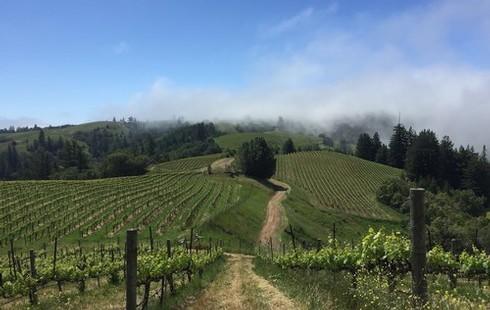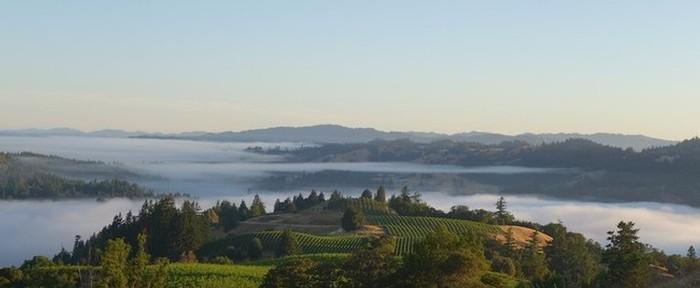By David Hirsch, September 2020
Everardo and I began planting West Ridge in 1992. Though it was only thirty years ago, our practices for winegrowing were radically different from what they are now. At that time, Hirsch Vineyards was an overgrazed sheep ranch. The redwoods and firs had been heavily logged without any regard for sustainability. After purchasing the ranch in 1979, we began planting new trees, and now the forest has come back to a healthy, flourishing stand. Viticulture was focused on yields with little emphasis on care for the soils. Labor was cheap and regulation minimal. All this has changed here with the introduction of biodynamic practices and care for the land, people, forest and community.
In the 1980s, the True Sonoma Coast, as a viticultural and marketing area, only existed in a few vineyards, one winery, and as a reality in very few minds. Our neighbor George Charles, whose son-in-law is Lee Martinelli, was unable in 1986 to sell his chardonnay and had to custom crush it. So in the 1980s, Gard Hellenthal (Hellenthal Vineyards), George Bohan (the Bohan Ranch) and I got to suck down bottles of delicious chard while watching the old Monday Night Football as George’s antenna was the only one able to receive the station. Now the vineyard is part of the Martinelli Winery portfolio.

In 1989, I visited Jeffrey Patterson at Mount Eden Vineyards, in the Santa Cruz Mountains. He was hosting some VIP customers and had consequently opened his best wines. There was one bottle in particular that struck me, and I asked Jeffrey to let me take cuttings from the vineyard that had produced it. He advised against it, warning me that the vineyard was heavily virused [1], resulting in low vigor and very low yields. In fact, Jeffrey was planning to replant the vineyard. Despite his warnings, I had fallen in love with the wine and took the cuttings back to Hirsch.
In 1992 we put in field 7, the foundation of the West Ridge, and grafted it to the Mount Eden cuttings. Our 2.5 acres of chard were planted directly north of field 7 in 1994 on a 45% slope. (It should be known as the Burt Williams Block. Having become infatuated with nebbiolo, I wanted to plant it there. When Burt heard this, he emphatically roared at me, “Plant chardonnay and I will buy it.” Burt knew!)
Block 6, the other foundational field on the West Ridge, went in in 1995, planted to the heritage California pinot clones of Pommard and Swan, and the Dijon clone 114. Block 12 was planted in 2002.

This completed the West Ridge. In 1994, the True Sonoma Coast became a reality for serious winemakers seeking pinot true to the variety as expressed in Burgundy. Burt Williams with his partner Ed Selyem, Ted Lemon of Littorai, and Steve Kistler began buying our fruit. Decanter Magazine in its review of the ’95 Littorai Hirsch Pinot called it perhaps the finest pinot yet sampled from the New World. Siduri, KJ’s Stonestreet division and others flocked to buy our fruit. This unique site, long a sheep pasturage and forest land, had become an icon for serious lovers of true pinot noir.
But the story is not over. 1998 was an El Niño year – 150” of rain fell from October to June. Living in our old cabin felt like being subjected to water torture. It just kept coming down, not so much in buckets, rather a continual flow of rain day in and out.
Until then, like many California grape growers of the time, l hadn’t paid much attention to the condition of the soils. Bob Uttermollen, one of the first agronomists to focus on vineyard soils in this area, did an analysis of our fields. They were quite acidic, especially on the West Ridge, probably from millennia of conifer deposits and heavy rain. A hundred years of sheep poop probably didn’t help. He recommended large applications of lime, mainly gypsum, to take away the excessive magnesium content. This reduced the acidity to a more neutral level.
Field 7 was highly serpentine, with way too much magnesium. 150” of rain over nine consecutive months had super-saturated the soil, which mildewed the fine root hairs, through which the vines take in water and nutrients. The vines went into serious decline. Being grafted to the virused Mt Eden clone stressed them even more.
Before 1998, Ted Lemon had announced that he would forever make wine from Field 7 and afterwards his sons would carry on. But after the El Niño year, he gave up on the block. The serpentine soils had formed a hard pan that deflected root growth and severely diminished the vigor of the vines.

I decided to rip out the vines in Block 7, but at the last moment an intuition hit me that we might learn much about the site if we tried to bring them back to life. With the help of a wonderful viticultural consultant, Lucie Morton, from of all places Virginia, we revived the soils and the plants. By amending the soils with lime and gypsum and breaking the shallow horizontal roots with a powerful tractor, the vines were able to grow their roots down into the subsoils. It took until 2005 for the vines to regain their vitality and vigor, and it wasn’t until 2007 that the true potential of the block began to show in the wines.
In 2007, one of California’s most exceptional vintages, we produced our first stand-alone bottlings from the West Ridge. Fifty cases of Block 7, and fifty cases of Block 6E. In 2009 we blended the two fields together, and thus the West Ridge was launched into the world of wine.
After my experiences with field 7, I became an amateur agronomist committed to explore, understand and revive our soils. From then on, soil work was the first priority before planting or replanting. In 2002, Field 12 with 1.4 acres of chardonnay and 4 acres of pinot was planted. This 5.4 acre field, after exhaustive soil analysis, was divided into nine separate blocks with dedicated rootstocks and clones. This lead to the application of compost and eventually the adoption of Biodynamic farming.
The Wines
The wines of the West Ridge tend to show a superb balance of fruit and acids, with well-integrated tannins. They have a gentle, supple personality, and are, shall we say, romantic. Their big brother East Ridge, only 600 yards to the east, tends to produce darker, more intense, fruit-driven wines. There the soils are not as acidic. When I came up here, the East Ridge was called Madrone Ridge. Perhaps there were fewer conifers leading to the lower acidity. Yet both Ridges express the signature of the site along with the integrity of the pinot variety, a testament to the complexity of their home.

Footnotes
[1] Block 7 is a true massale selection, with a diverse genetic makeup. The lineage of these plants can be traced back to Paul Masson, who brought Pinot Noir cuttings from Burgundy to California in the late 1800s and planted them in the Santa Cruz Mountains. The genetic diversity of the plants imparts greater complexity to the wine, but also perpetuates leaf-roll virus that came with the vines from Burgundy. The virus inhibits the ability of the vines to carry out photosynthesis and produce sugar.
